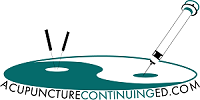Utah
UTAH Law and education regarding PIT
Statute
https://le.utah.gov/xcode/Title58/Chapter72/58-72-S102.html?v=C58-72-S102_1800010118000101
R156. Commerce, Occupational and Professional Licensing. R156-72. Acupuncture Licensing Act Rule.
R156-72-101. Title.
This rule is known as the “Acupuncture Licensing Act Rule”.
R156-72-102. Definitions.
In addition to the definitions in Title 58, Chapter 1, Division of Occupational and Professional Licensing Act, and Title 58, Chapter 72, Acupuncture Licensing Act, the following rule definitions supplement the statutory definitions:
(1) “ACAOM” means the Accreditation Commission for Acupuncture and Oriental Medicine.
(2) “According to practitioner training” in Subsection 58-72-102(5)(b)(ii) means that the licensee has completed education and training from an educational program accredited or recognized by ACAOM regarding the recommendation, administration, or provision of dietary guidelines, herbs, supplements, homeopathics, and therapeutic exercise.
(3) “Administration” in Subsection 58-72-102(5)(b)(ii) means the direct application of an herb, homeopathic, or supplement to the body of a patient by:
(a) ingestion;
(b) topical application;
(c) inhalation; or
(d) point injection therapy (PIT).
(4) “Herbs” and “homeopathics” in Subsection 58-72-102(5)(b)(ii) may include:
(a) vitamins;
(b) minerals;
(c) amino acids;
(d) proteins; and
(e) enzymes.
(5) “Insertion of acupuncture needles” in Subsection 58-72-102(5)(a) means a procedure of acupuncture and oriental
medicine including myofascial trigger point therapy, intramuscular therapy, perineural injection therapy (PIT), prolotherapy, proprioceptive stimulation, Ashi points, or dry needling techniques.
(6) “Modern research” in Subsection 58-72-102(5)(b)(ii) means practicing according to acupuncture and oriental medicine education and training as recognized through NCCAOM.
(7) “NCCAOM” means the National Commission for the Certification of Acupuncture and Oriental Medicine, formerly known as the National Commission for the Certification of Acupuncturists (NCCA).
R156-72-103. Authority – Purpose.
This rule is adopted by the Division under the authority of Subsection 58-1-106(1)(a) to enable the Division to administer Title 58, Chapter 72.
R156-72-104. Organization – Relationship to Rule R156-1.
The organization of this rule and its relationship to Rule R156-1 is as described in Section R156-1-107.
R156-72-302a. Qualifications for Licensure – Certification and Exam Requirements.
In accordance with Subsections 58-72-302(3) and (4), to meet the requirements for current active certification in acupuncture under guidelines established by NCCAOM, and the requirements for passing the examination required by the Division, an applicant for licensure as a licensed acupuncturist shall submit documentation of:
(1) current and active NCCAOM certification; or
(2) pursuant to Subsection 58-1-302(1), licensure in good standing as an acupuncturist in any state, district, or territory of the United States, for at least one year immediately preceding the application.
R156-72-302b. Qualifications for Licensure – Animal Acupuncture.
In accordance with Subsections 58-28-307(12)(d) and 58-72-102(5)(b)(iii), to engage in the practice of animal acupuncture, a licensed acupuncturist shall complete 100 hours of animal acupuncture training and education that includes:
(1) fifty hours of on the job training under the indirect supervision of a licensed veterinarian; (2) animal anatomy training; and
(3) the remaining hours in animal specific continuing education.
R156-72-302c. Informed Consent.
(1) In accordance with Subsection 58-72-302(5), to enable patients to give informed consent to treatment, a licensed acupuncturist shall have a patient chart for each patient that includes:
(a) a written review of symptoms;
(b) a statement signed by the patient consenting to acupuncture treatment; and
(c) if the patient is receiving an adjunctive therapy as defined in Subsection 58-72-102(5), a written disclosure signed by
the patient regarding the licensed acupuncturist’s education and training to perform that therapy.
(2) In accordance with Section 58-72-503, patient records, including records documenting informed consent, shall be maintained for seven years.
R156-72-303. Renewal Cycle – Procedures.
(1) In accordance with Subsection 58-1-308(1), the renewal date for the two-year renewal cycle applicable to licensees under Title 58, Chapter 72, Acupuncture Licensing Act, is established by rule in Section R156-1-308a.
(2) Renewal procedures shall be in accordance with Sections R156-1-308b through R156-1-308l.
(3) In accordance with Subsections 58-1-308(3)(b) and 58-72-303(3), a licensee who does not maintain current and active NCCAOM certification shall:
(a) complete at least 30 continuing education units (CEU) or 30 professional didactic activity (PDA) points within the two-year renewal period; and
(b) maintain current BLS-CPR certification.
R156-72-503. Unprofessional Conduct.
In accordance with Subsection 58-72-102(6), “unprofessional conduct” includes:
(1) failing to maintain office, instruments, equipment, appliances, or supplies in a safe and sanitary condition;
(2) violating Subsection 58-72-303(3) regarding renewal qualifications by:
(a) failing to maintain current and active NCCAOM certification;
(b) failing to complete all CEUs required under Subsection R156-72-303(3); or
(c) failing to maintain current BLS-CPR certification;
(3) failing to abide by the NCCAOM Code of Ethics revised January 1, 2016, that is hereby incorporated by reference; (4) failing to maintain patient records for a seven-year period;
(5) recommending, administering, or providing dietary guidelines, herbs, supplements, homeopathics, or therapeutic
exercise without having completed the required practitioner training pursuant to Subsection 58-72-102(5)(b)(ii) and Subsection R156-72-102(2); or
(6) administering venous injections, immunizations, or controlled substances.
KEY: acupuncture, licensing
Date of Last Change: March 25, 2021
Notice of Continuation: September 7, 2021
Authorizing, and Implemented or Interpreted Law: 58-72-101; 58-1-106(1)(a); 58-1-202(1)(a)
Affected by 63I-1-258 on 7/1/2021
58-72-102. Acupuncture licensing — Definitions.
In addition to the definitions in Section 58-1-102, as used in this chapter:
| (1) | “Board” means the Acupuncture Licensing Board created in Section 58-72-201. |
| (3) | “Licensed acupuncturist,” designated as “L.Ac.,” means a person who has been licensed under this chapter to practice acupuncture. |
| (4) | “Moxibustion” means a heat therapy that uses the herb moxa to heat acupuncture points of the body. |
| (5) |
|
| (6) | “Unprofessional conduct” is as defined in Sections 58-1-501 and 58-72-503, and as may be further defined by division rule. |
Amended by Chapter 485, 2019 General Session
